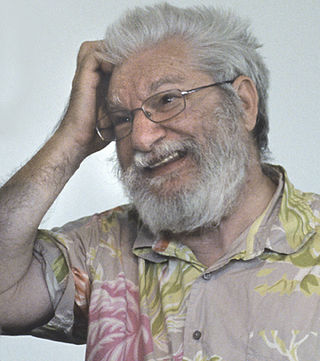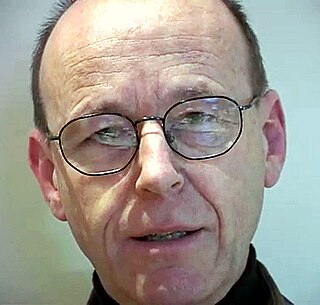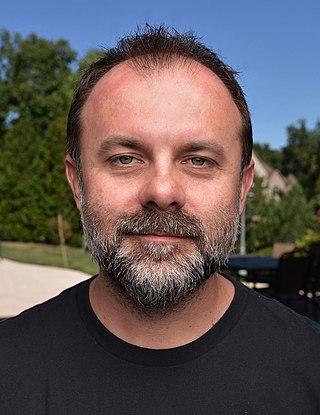Video installation is a contemporary art form that combines video technology with installation art, making use of all aspects of the surrounding environment to affect the audience. Tracing its origins to the birth of video art in the 1970s, it has increased in popularity as digital video production technology has become more readily accessible. Today, video installation is ubiquitous and visible in a range of environments—from galleries and museums to an expanded field that includes site-specific work in urban or industrial landscapes. Popular formats include monitor work, projection, and performance. The only requirements are electricity and darkness.

Marco Brambilla is an Italian-born Canadian contemporary artist and film director, known for re-contextualizations of popular and found imagery, and use of 3D imaging technologies in public installations and video art.

Daniel Graham was an American visual artist, writer, and curator in the writer-artist tradition. In addition to his visual works, he published a large array of critical and speculative writing that spanned the spectrum from heady art theory essays, reviews of rock music, Dwight D. Eisenhower's paintings, and Dean Martin's television show. His early magazine-based art predates, but is often associated with, conceptual art. His later work focused on cultural phenomena by incorporating photography, video, performance art, glass and mirror installation art structures, and closed-circuit television. He lived and worked in New York City.
Tony Oursler is an American multimedia and installation artist married to Jacqueline Humphries. He completed a Bachelor of Fine Arts at the California Institute for the Arts, Valencia, California in 1979. His art covers a range of mediums, working with video, sculpture, installation, performance, and painting. The artist currently lives and works in New York City.

Doug Aitken is an American multidisciplinary artist. Aitken's body of work ranges from photography, print media, sculpture, and architectural interventions, to narrative films, sound, single and multi-channel video works, installations, and live performance. He currently lives in Venice, California, and New York City.

Anthony McCall is a British-born New York based artist known for his ‘solid-light’ installations, a series that he began in 1973 with "Line Describing a Cone," in which a volumetric form composed of projected light slowly evolves in three-dimensional space.

Robert Whitman was an American artist best known for his seminal theater pieces of the early 1960s combining visual and sound images, actors, film, slides, and evocative props in environments of his own making. From the late 1960s on he worked with new technologies, and his latest work incorporated cellphones.

Zlatko Ćosić is a video artist born in Banja Luka, Yugoslavia whose work includes short films, video installations, theater and architectural projections, and audio-visual performances. Ćosić's experience as a refugee influenced and shaped the content of his early artistic practice. His work began with the challenges of immigration and shifting identities, evolving to socio-political issues related to injustice, consumerism, and climate crisis. Ćosić's artwork has been shown in over fifty countries in exhibitions such as the Contemporary Art Museum St. Louis, Ann Arbor Film Festival, Video Vortex XI at Kochi-Muziris Biennale, ZKM Center for Art and Media Karlsruhe, St. Louis International Film Festival, Torrance Art Museum, Alchemy Film & Moving Image Festival, /si:n/ Video Art and Performance Biennale, Institut Für Alles Mögliche, the Pulitzer Arts Foundation, Kunstverein Kärnten, Art Speaks Out at 2022 United Nations Climate Change Conference, and the Research Pavilion at the 57th Venice Biennale. Ćosić has received grants and fellowships including the Regional Arts Commission Artist Fellowship, a Kranzberg Grant for a video installation at Laumeier Sculpture Park, and the WaveMaker Grant, Locust Projects, supported by the Andy Warhol Foundation.
One of the principal features defining traditional cinema is a fixed and linear narrative structure. In Database Cinema however, the story develops by selecting scenes from a given collection like a computer game in which a player performs certain acts and thereby selects scenes and creating a narrative.

Light art or the art of light is generally referring to a visual art form in which (physical) light is the main, if not sole medium of creation. Uses of the term differ drastically in incongruence; definitions, if existing, vary in several aspects. Since light is the medium for visual perception, this way all visual art could be considered light art absurdly enough; but most pieces of art are valid and coherent without reflecting on this basic perceptual fact. Some approaches on these grounds also include into light art those forms of art where light is not any medium contributing to the artwork, but is depicted. Thus, luminism may also refer to light art in the above sense, its previous usage point to painterly styles: either as an other label for the Caravaggisti in the baroque, or 19th and 20th centuries, fundamentally impressionist schools.
Peter Sarkisian is an American new media artist based in Santa Fe, New Mexico. He combines video projection and sculpture to create hybrid-format, multi-media installations.
Matthew Dalziel and Louise Scullion, known professionally as Dalziel + Scullion, are a Scottish artist duo. Dalziel and Scullion have worked in collaboration since 1993. Their studio creates artworks in photography, video, sound and sculpture that explore new artistic languages surrounding the subject of ecology.
Paul Sermon was born 23 March 1966, in Oxford, England. Since September 2013 he has worked as Professor of Visual Communication in the Faculty of Arts at the University of Brighton.

New media art includes artworks designed and produced by means of electronic media technologies. It comprises virtual art, computer graphics, computer animation, digital art, interactive art, sound art, Internet art, video games, robotics, 3D printing, immersive installation and cyborg art. The term defines itself by the thereby created artwork, which differentiates itself from that deriving from conventional visual arts such as architecture, painting or sculpture.

Mike Stubbs is a curator/director and filmmaker based in the UK, currently, the Creative Producer at Doncaster Creates. For 11 years he was the Director/CEO of FACT, the Foundation for Art and Creative Technology, a leading arts organisation for the commissioning and presentation of new media art forms. He has been a key contributor to the development of culture and cultural policy in Liverpool, UK. Stubbs was jointly appointed in May 2007 by Liverpool John Moores University, where he is Professor of Art, Media and Curating. He is father to two daughters Saskia and Lola Czarnecki-stubbs.
Davy McGuire and Kristin McGuire, co-directors of Studio McGuire, are British multimedia artists. They create experiential artworks within the mediums of projection mapping, theatre, fine art, animation, moving image, art installations, video games and immersive technologies.
Graham Cairns is an author and academic. He is the founder and director of the research organisation AMPS Architecture Media Politics Society. He is Executive Editor of its associated peer-reviewed scholarly journal Architecture_MPS, ISSN 2050-9006, published by UCL Press. He researches and publishes on architecture and its relationship with visual culture and socio-politics. He has delivered talks, taught, ran workshops and held various positions at universities internationally.
Perry Bard lives and works in New York City. She is an interdisciplinary artist who works with film, site-specific public art installation projects around the world, and on the Internet.

Chiara Passa is a visual artist working in media art since the second half of the 1990s.

minus20degree is a contemporary art and architecture exhibition that takes place every 2 years in Flachau, Austria during winter. The exhibition lasts for 3 days in January. The biennale was founded by Theo Deutinger, Stefanos Filippas, Ana Rita Marques, Eliza Mante, and Heinz Riegler.













